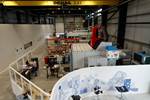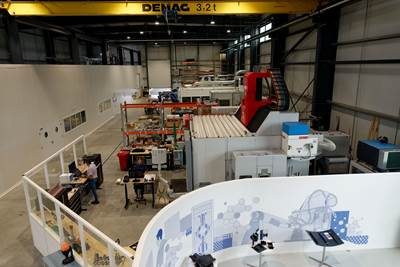Blue Origin successfully tests escape system, lands New Shepard rocket
On Oct. 5, the company successfully conducted an in-flight escape test of its New Shepard system.
Blue Origin warned its next flight was going to be dramatic, no matter how it ended. So Oct. 5 was a good news day for the company as it successfully conducted an in-flight escape test of its New Shepard system, which is a fully reusable rocket and capsule. Everything went according to plan, taking the company one big step toward its goal of carrying people into space.
According to :
New Shepard blasted off from Blue Origin's test range in west Texas at 11:36 a.m. EDT (1536 GMT), kicking off today's uncrewed test. About 45 seconds into flight, at an altitude of 16,000 feet (5,000 meters), the capsule fired its onboard "escape motor" for 2 seconds, blasting itself hundreds of feet clear of the booster.
Blue Origin owner and billionaire entrepreneur Jeff Bezos in a blog article that this flight would be its toughest test yet:
About 45 seconds after liftoff at about 16,000 feet, we’ll intentionally command escape. Redundant separation systems will sever the crew capsule from the booster at the same time we ignite the escape motor. The escape motor will vector thrust to steer the capsule to the side, out of the booster’s path. The high acceleration portion of the escape lasts less than two seconds, but by then the capsule will be hundreds of feet away and diverging quickly. It will traverse twice through transonic velocities – the most difficult control region – during the acceleration burn and subsequent deceleration. The capsule will then coast, stabilized by reaction control thrusters, until it starts descending. Its three drogue parachutes will deploy near the top of its flight path, followed shortly thereafter by main parachutes.
wrote:
At 11:41 a.m. EDT (1541 GMT), the New Shepard capsule landed softly under parachutes in the Texas desert as planned, raising a huge plume of dust as it hit the ground.
And of the booster? About three minutes later, the booster landed vertically on the launch pad. Bezos had predicted earlier the test would destroy it:
We’d really like to retire it after this test and put it in a museum. Sadly, that’s not likely. This test will probably destroy the booster. The booster was never designed to survive an in-flight escape. The capsule escape motor will slam the booster with 70,000 pounds of off-axis force delivered by searing hot exhaust. The aerodynamic shape of the vehicle quickly changes from leading with the capsule to leading with the ring fin, and this all happens at maximum dynamic pressure. Nevertheless, the booster is very robust and our Monte Carlo simulations show there’s some chance we can fly through these disturbances and recover the booster. If the booster does manage to survive this flight – its fifth – we will in fact reward it for its service with a retirement party and put it in a museum. In the more likely event that we end up sacrificing the booster in service of this test, it will still have most of its propellant on board at the time escape is triggered, and its impact with the desert floor will be most impressive.
"Wow. There it is. There you go, New Shepard. Look at her," launch commentator Ariane Cornell said once the booster landed. "What an extraordinary test and a tremendous final flight for both craft."
Check out video of the in-flight escape test below:
Related Content
Infinite Composites: Type V tanks for space, hydrogen, automotive and more
After a decade of proving its linerless, weight-saving composite tanks with NASA and more than 30 aerospace companies, this CryoSphere pioneer is scaling for growth in commercial space and sustainable transportation on Earth.
Read MorePlant tour: Aernnova Composites, Toledo and Illescas, Spain
RTM and ATL/AFP high-rate production sites feature this composites and engineering leader’s continued push for excellence and innovation for future airframes.
Read MoreFirst Airbus A350 crash confirmed in Haneda
Shortly after touch-down, a JAL A350-900 aircraft recently collided with a De Havilland Canada Dash 8. Exact circumstances are still unknown.
Read MorePlant tour: Airbus, Illescas, Spain
Airbus’ Illescas facility, featuring highly automated composites processes for the A350 lower wing cover and one-piece Section 19 fuselage barrels, works toward production ramp-ups and next-generation aircraft.
Read MoreRead Next
Composites end markets: New space (2025)
Composite materials — with their unmatched strength-to-weight ratio, durability in extreme environments and design versatility — are at the heart of innovations in satellites, propulsion systems and lunar exploration vehicles, propelling the space economy toward a $1.8 trillion future.
Read MorePlant tour: Daher Shap’in TechCenter and composites production plant, Saint-Aignan-de-Grandlieu, France
Co-located R&D and production advance OOA thermosets, thermoplastics, welding, recycling and digital technologies for faster processing and certification of lighter, more sustainable composites.
Read More“Structured air” TPS safeguards composite structures
Powered by an 85% air/15% pure polyimide aerogel, Blueshift’s novel material system protects structures during transient thermal events from -200°C to beyond 2400°C for rockets, battery boxes and more.
Read More












